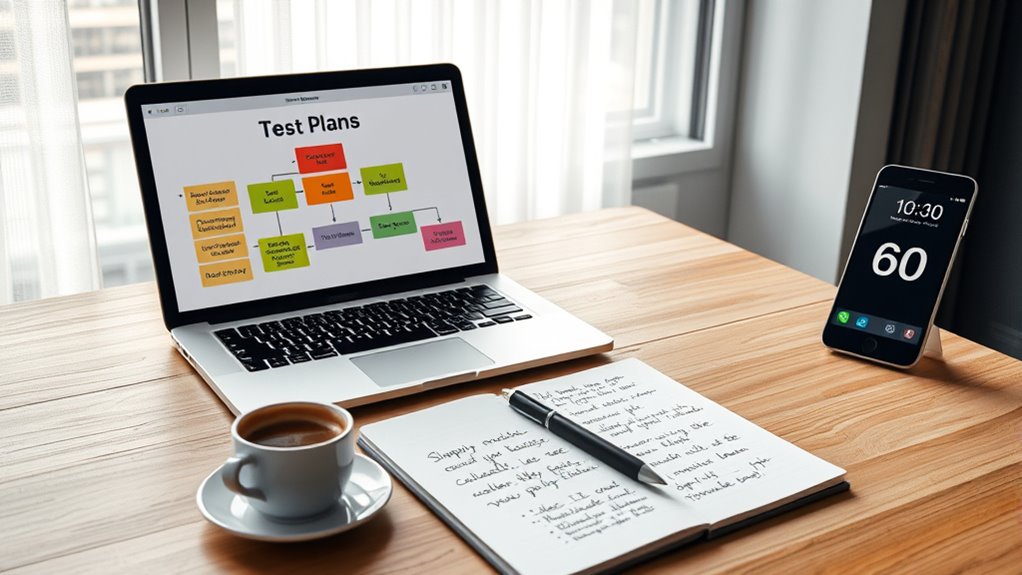To build a minimal viable test plan in 60 minutes, focus on identifying your product’s core features and features that deliver its main value. Prioritize high-risk areas and automate key tests for quick feedback. Keep your plan simple, flexible, and targeting only essential workflows. Use risk assessment to guide testing efforts and guarantee coverage on critical issues. If you want to learn how to streamline this process further, there’s more to explore below.
Key Takeaways
- Identify and prioritize the product’s core features essential for its main function.
- Develop a simple, focused test plan targeting high-risk and high-value areas.
- Use automation for repetitive tests and critical workflows to save time.
- Conduct a quick risk assessment to allocate testing efforts efficiently.
- Keep the plan flexible, focusing on key test cases to validate the product rapidly.

Creating a minimal viable test plan is essential for efficiently verifying your product’s core functionality without overextending resources. When you’re pressed for time but still need confidence in your testing process, focusing on the essentials becomes critical. The goal is to identify and test the features that matter most, ensuring your product delivers value without getting bogged down in exhaustive testing. To do this effectively, start by clearly defining what constitutes the core functionality of your product. Ask yourself: what features are absolutely necessary for the product to perform its primary function? These are the areas where you’ll concentrate your testing efforts.
Focus on testing core features that matter most to ensure product value under tight deadlines.
Next, leverage test automation to speed up the process. Automated tests allow you to quickly verify repetitive tasks and core functionalities with minimal manual intervention. By scripting tests for critical workflows and frequently used features, you can save time and ensure consistency in your testing. Automation also helps catch regressions early, especially when you’re working under a tight timeline. However, don’t forget that test automation isn’t a cure-all; it’s most effective when paired with a clear risk assessment. Identify potential failure points and areas that could *substantially* impact user experience or system stability. This prioritization ensures you focus your limited testing resources on the parts of your product that pose the greatest risk if they fail.
Risk assessment should be integrated from the very beginning. It guides your decisions about what to test and how much coverage is enough. For example, if a particular feature has a history of bugs or is critical to your application’s success, it warrants more thorough testing, possibly even manual testing or additional automation scripts. Conversely, less *crucial* features or those with minimal impact on the overall user experience might only need minimal checks or simple tests. This targeted approach maximizes your testing efficiency, ensuring you spend your limited time where it counts most. Additionally, understanding asset division principles can help prioritize testing efforts by focusing on the most critical components of your product.
Finally, keep your test plan lean and adaptable. As you develop it within 60 minutes, focus on the key test cases that cover the primary user flows. Document your assumptions and prioritize tests that will give you the highest confidence in your product’s core functionality. Remember, a minimal viable test plan isn’t about cutting corners; it’s about smartly concentrating your efforts where they make the most difference. With a clear focus on automation and risk assessment, you’ll be able to create a practical, effective test plan that gets your product validated quickly and reliably, even under tight deadlines.
Frequently Asked Questions
How Do I Prioritize Test Cases Effectively?
To prioritize test cases effectively, you should focus on test case relevance by evaluating each case’s impact and likelihood of uncovering critical issues. Use prioritization strategies like risk-based testing, which targets high-risk areas first, and business importance, ensuring essential features are tested early. Keep your plan flexible, and regularly revisit priorities as project needs evolve. This approach helps you maximize testing efficiency and catch the most significant defects quickly.
What Tools Can Speed up Test Plan Creation?
To speed up test plan creation, leverage tools that support test automation and risk analysis. Use test management software like TestRail or Zephyr to quickly organize cases and track progress. Incorporate risk analysis tools to identify high-priority areas, ensuring you’re focusing on critical tests first. Automation tools like Selenium or Cypress can help run repetitive tests faster, saving time and improving accuracy in your test plan development process.
How Do I Handle Unexpected Test Failures Quickly?
When you face unexpected test failures, focus on swift test failure analysis to identify root causes quickly. Use rapid troubleshooting techniques like isolating variables and reviewing recent changes to pinpoint issues fast. Keep a checklist handy to streamline steps and avoid delays. Document findings immediately to inform adjustments and prevent recurring problems. This proactive approach guarantees you resolve failures efficiently, keeping your testing process on track and minimizing downtime.
What Are Common Pitfalls When Building a Minimal Test Plan?
Poor planning, pinpointing problems, and piling on tests are common pitfalls in test planning. You might overlook critical risks, ignore scope, or get stuck in superfluous steps. To avoid these, focus on clear risk assessment, prioritize essential tests, and keep your plan simple and specific. Staying vigilant about potential pitfalls helps you craft a concise, effective test plan that catches issues early without wasting time or resources.
How Can I Ensure Test Coverage Without Overcomplicating?
To guarantee test coverage without overcomplicating, focus on key features and risk areas, and leverage test automation to streamline repetitive tasks. Keep stakeholder communication clear and concise, involving the right people early to identify critical requirements. Prioritize tests that deliver maximum value, and avoid unnecessary details. This approach helps you balance extensive coverage with simplicity, ensuring effective testing without overwhelming your process or team.
Conclusion
Now that you’ve got the basics down, you’re ready to draft your test plan in no time. Remember, it’s better to have a simple, actionable plan than to get bogged down in details that can wait. Keep it lean, focus on core risks, and don’t be afraid to iterate as you learn. With this approach, you’ll be able to hit the ground running and make sure your testing efforts are right on the money.









